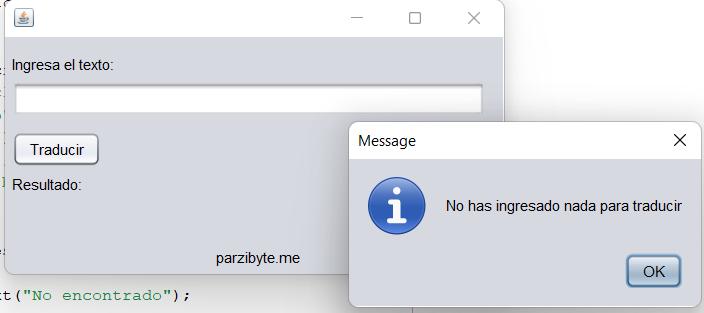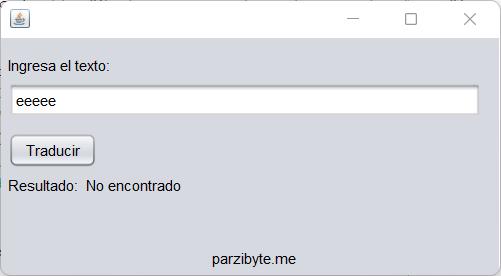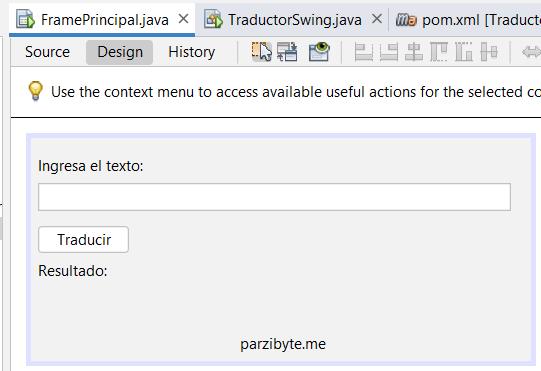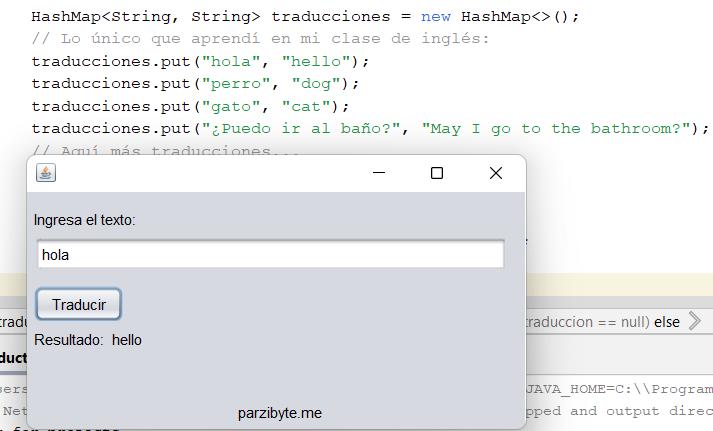El día de hoy te mostraré un sencillo proyecto con interfaz gráfica en Java. Se trata de una aplicación que sirve de traductor, con traducciones estáticas (es decir, las define el programador).
Al final tendremos una ventana con un campo de texto en donde vamos a escribir el texto y luego con un botón se va a traducir y mostrar el resultado en caso de que exista esa traducción.
Con esto podrás hacer un traductor de cualquier tipo, de cualquier idioma o de símbolos.
Explicación del algoritmo
Este proyecto será realmente sencillo. Ya expliqué la estructura de la ventana anteriormente, entonces lo que haremos cuando se presione el botón para traducir será lo siguiente:
- Obtener el texto que se desea traducir
- Si el texto está vacío (longitud 0) mostramos un mensaje de error y detenemos la función

- En caso de que el texto sí exista, entonces lo buscamos en nuestro mapa (sería un diccionario de traducciones) que será un HashMap
- Si la traducción existe, la mostramos. Si no, indicamos que la traducción no se encontró.

Todo eso lo haremos modificando los JLabel y todo eso, pero el algoritmo es el que acabo de explicar.
Diseño de la ventana
Tenemos el siguiente diseño para nuestro traductor en Java con interfaz gráfica. Lo que importa es el campo de texto, el botón y la etiqueta de resultado:

Toma en cuenta que el campo de texto se llama jTextFieldEntrada, el botón jButtonTraducir y la etiqueta de resultado (que no es visible) es jLabelResultado.
Las traducciones
Antes de pasar a la traducción con Java veamos el diccionario de traducciones. Aquí puedes poner cualquier palabra y su traducción:
HashMap<String, String> traducciones = new HashMap<>();
// Lo único que aprendí en mi clase de inglés:
traducciones.put("hola", "hello");
traducciones.put("perro", "dog");
traducciones.put("gato", "cat");
traducciones.put("¿Puedo ir al baño?", "May I go to the bathroom?");
En este ejemplo tengo unas cosas en inglés pero obviamente puede ser de cualquier tipo o idioma.
Puedes invocar a put cuantas veces sea necesario, poniendo el texto en idioma original y después su traducción.
Recuerda que ya dejé el tutorial del hashmap más arriba, y no olvides importarlo con import java.util.HashMap.
Traducir
Vamos al evento del clic del botón. Es realmente muy simple, y gracias al diccionario nos ahorramos comparaciones largas o cosas de esas.
La traducción se está obteniendo en la línea 15. Ahí sucede la magia.
private void jButtonTraducirActionPerformed(java.awt.event.ActionEvent evt) {
String entrada = this.jTextFieldEntrada.getText();
if (entrada.length() <= 0) {
JOptionPane.showMessageDialog(null, "No has ingresado nada para traducir");
return;
}
HashMap<String, String> traducciones = new HashMap<>();
// Lo único que aprendí en mi clase de inglés:
traducciones.put("hola", "hello");
traducciones.put("perro", "dog");
traducciones.put("gato", "cat");
traducciones.put("¿Puedo ir al baño?", "May I go to the bathroom?");
// Aquí más traducciones...
String traduccion = traducciones.get(entrada);
if (traduccion == null) {
this.jLabelResultado.setText("No encontrado");
} else {
this.jLabelResultado.setText(traduccion);
}
}
Nota: para una mejor coincidencia puede que quieras convertir a minúscula el texto de entrada y también definir todo en minúsculas en el diccionario, así no importará si el usuario escribe en mayúscula o minúscula.
Poniendo todo junto

Solo como referencia, el código completo queda como se ve a continuación. No recomiendo copiar y pegar el código pues puede ser distinto, solo recomiendo copiar el del evento del clic del botón que ya dejé anteriormente.
Lo interesante está en la línea 110:
/*
* Click nbfs://nbhost/SystemFileSystem/Templates/Licenses/license-default.txt to change this license
* Click nbfs://nbhost/SystemFileSystem/Templates/GUIForms/JFrame.java to edit this template
*/
package me.parzibyte.traductorswing;
import java.util.HashMap;
import javax.swing.JOptionPane;
/**
*
* @author parzibyte
*/
public class FramePrincipal extends javax.swing.JFrame {
/**
* Creates new form FramePrincipal
*/
public FramePrincipal() {
initComponents();
}
/**
* This method is called from within the constructor to initialize the form.
* WARNING: Do NOT modify this code. The content of this method is always
* regenerated by the Form Editor.
*/
@SuppressWarnings("unchecked")
// <editor-fold defaultstate="collapsed" desc="Generated Code">
private void initComponents() {
jTextFieldEntrada = new javax.swing.JTextField();
jLabel1 = new javax.swing.JLabel();
jButtonTraducir = new javax.swing.JButton();
jLabelResultado = new javax.swing.JLabel();
jLabel2 = new javax.swing.JLabel();
jLabel3 = new javax.swing.JLabel();
setDefaultCloseOperation(javax.swing.WindowConstants.EXIT_ON_CLOSE);
jTextFieldEntrada.addActionListener(new java.awt.event.ActionListener() {
public void actionPerformed(java.awt.event.ActionEvent evt) {
jTextFieldEntradaActionPerformed(evt);
}
});
jLabel1.setText("Ingresa el texto:");
jLabel1.setAutoscrolls(true);
jButtonTraducir.setText("Traducir");
jButtonTraducir.addActionListener(new java.awt.event.ActionListener() {
public void actionPerformed(java.awt.event.ActionEvent evt) {
jButtonTraducirActionPerformed(evt);
}
});
jLabel2.setText("Resultado:");
jLabel3.setText("parzibyte.me");
javax.swing.GroupLayout layout = new javax.swing.GroupLayout(getContentPane());
getContentPane().setLayout(layout);
layout.setHorizontalGroup(
layout.createParallelGroup(javax.swing.GroupLayout.Alignment.LEADING)
.addGroup(layout.createSequentialGroup()
.addContainerGap()
.addGroup(layout.createParallelGroup(javax.swing.GroupLayout.Alignment.TRAILING)
.addGroup(javax.swing.GroupLayout.Alignment.LEADING, layout.createSequentialGroup()
.addComponent(jLabel2)
.addPreferredGap(javax.swing.LayoutStyle.ComponentPlacement.RELATED)
.addComponent(jLabelResultado, javax.swing.GroupLayout.PREFERRED_SIZE, 277, javax.swing.GroupLayout.PREFERRED_SIZE))
.addGroup(layout.createParallelGroup(javax.swing.GroupLayout.Alignment.TRAILING)
.addComponent(jTextFieldEntrada, javax.swing.GroupLayout.PREFERRED_SIZE, 378, javax.swing.GroupLayout.PREFERRED_SIZE)
.addComponent(jButtonTraducir, javax.swing.GroupLayout.Alignment.LEADING)
.addComponent(jLabel1, javax.swing.GroupLayout.Alignment.LEADING)))
.addContainerGap(16, Short.MAX_VALUE))
.addGroup(javax.swing.GroupLayout.Alignment.TRAILING, layout.createSequentialGroup()
.addContainerGap(javax.swing.GroupLayout.DEFAULT_SIZE, Short.MAX_VALUE)
.addComponent(jLabel3)
.addGap(164, 164, 164))
);
layout.setVerticalGroup(
layout.createParallelGroup(javax.swing.GroupLayout.Alignment.LEADING)
.addGroup(layout.createSequentialGroup()
.addGap(14, 14, 14)
.addComponent(jLabel1)
.addPreferredGap(javax.swing.LayoutStyle.ComponentPlacement.RELATED)
.addComponent(jTextFieldEntrada, javax.swing.GroupLayout.PREFERRED_SIZE, javax.swing.GroupLayout.DEFAULT_SIZE, javax.swing.GroupLayout.PREFERRED_SIZE)
.addPreferredGap(javax.swing.LayoutStyle.ComponentPlacement.UNRELATED)
.addComponent(jButtonTraducir)
.addPreferredGap(javax.swing.LayoutStyle.ComponentPlacement.RELATED)
.addGroup(layout.createParallelGroup(javax.swing.GroupLayout.Alignment.LEADING, false)
.addComponent(jLabel2, javax.swing.GroupLayout.DEFAULT_SIZE, javax.swing.GroupLayout.DEFAULT_SIZE, Short.MAX_VALUE)
.addComponent(jLabelResultado, javax.swing.GroupLayout.DEFAULT_SIZE, javax.swing.GroupLayout.DEFAULT_SIZE, Short.MAX_VALUE))
.addPreferredGap(javax.swing.LayoutStyle.ComponentPlacement.RELATED, 42, Short.MAX_VALUE)
.addComponent(jLabel3)
.addContainerGap())
);
jLabel1.getAccessibleContext().setAccessibleName("");
jLabel1.getAccessibleContext().setAccessibleDescription("");
pack();
}// </editor-fold>
private void jTextFieldEntradaActionPerformed(java.awt.event.ActionEvent evt) {
// TODO add your handling code here:
}
private void jButtonTraducirActionPerformed(java.awt.event.ActionEvent evt) {
String entrada = this.jTextFieldEntrada.getText();
if (entrada.length() <= 0) {
JOptionPane.showMessageDialog(null, "No has ingresado nada para traducir");
return;
}
HashMap<String, String> traducciones = new HashMap<>();
// Lo único que aprendí en mi clase de inglés:
traducciones.put("hola", "hello");
traducciones.put("perro", "dog");
traducciones.put("gato", "cat");
traducciones.put("¿Puedo ir al baño?", "May I go to the bathroom?");
// Aquí más traducciones...
String traduccion = traducciones.get(entrada);
if (traduccion == null) {
this.jLabelResultado.setText("No encontrado");
} else {
this.jLabelResultado.setText(traduccion);
}
}
/**
* @param args the command line arguments
*/
public static void main(String args[]) {
/* Set the Nimbus look and feel */
//<editor-fold defaultstate="collapsed" desc=" Look and feel setting code (optional) ">
/* If Nimbus (introduced in Java SE 6) is not available, stay with the default look and feel.
* For details see http://download.oracle.com/javase/tutorial/uiswing/lookandfeel/plaf.html
*/
try {
for (javax.swing.UIManager.LookAndFeelInfo info : javax.swing.UIManager.getInstalledLookAndFeels()) {
if ("Nimbus".equals(info.getName())) {
javax.swing.UIManager.setLookAndFeel(info.getClassName());
break;
}
}
} catch (ClassNotFoundException ex) {
java.util.logging.Logger.getLogger(FramePrincipal.class.getName()).log(java.util.logging.Level.SEVERE, null, ex);
} catch (InstantiationException ex) {
java.util.logging.Logger.getLogger(FramePrincipal.class.getName()).log(java.util.logging.Level.SEVERE, null, ex);
} catch (IllegalAccessException ex) {
java.util.logging.Logger.getLogger(FramePrincipal.class.getName()).log(java.util.logging.Level.SEVERE, null, ex);
} catch (javax.swing.UnsupportedLookAndFeelException ex) {
java.util.logging.Logger.getLogger(FramePrincipal.class.getName()).log(java.util.logging.Level.SEVERE, null, ex);
}
//</editor-fold>
/* Create and display the form */
java.awt.EventQueue.invokeLater(new Runnable() {
public void run() {
new FramePrincipal().setVisible(true);
}
});
}
// Variables declaration - do not modify
private javax.swing.JButton jButtonTraducir;
private javax.swing.JLabel jLabel1;
private javax.swing.JLabel jLabel2;
private javax.swing.JLabel jLabel3;
private javax.swing.JLabel jLabelResultado;
private javax.swing.JTextField jTextFieldEntrada;
// End of variables declaration
}
Para terminar te dejo con más tutoriales de Java en mi blog. Por cierto, este proyecto fue el que usé para enseñarte a compilar una aplicación de Java.